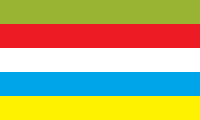|
Kotava
Kotava (sometimes also spelled Kodava) is an international auxiliary language (IAL) created by Staren Fetcey in 1978 that focuses on the principle of cultural neutrality. The name means "the language of one and all", and the Kotava community has adopted the slogan "a project humanistic and universal, utopian and realistic". The language is mainly known in French-speaking countries and most learning materials for it are in French. HistoryKotava was invented by Staren Fetcey, a Canadian traveler and linguist, who began the project in the summer of 1975, on the basis of her study of previous IAL projects. The language was first made available to the public in 1978, and two major revisions were made in 1988 and 1993. Since then, the language has stabilized, with a lexicon of more than 17,000 basic roots. In 2005, a committee of seven members was established with the responsibility of guiding the future evolution of the language. The overall goal was to create a potential IAL that was not based on a particular cultural substrate. To do this, a number of subgoals were established:
PropertiesClassificationAs an a priori constructed language, Kotava is not related to any other language, natural or constructed. The word order is very free, but current practice leans toward object–subject–verb. All objects and other complements must be introduced by prepositions. There are also innovations involving conjunctions and prepositions (its system of locative prepositions). AlphabetKotava is written with the Latin alphabet but does not use the letters H or Q. The letter H, which was used only to palatalize a preceding L, M, or N, was eliminated and replaced by the letter Y in all cases. The only diacritic is an acute accent indicating stress on the final vowel in the first person of verbs. Like in French, a space is added between text and exclamation or question marks. PhonologyIn Kotava, there are no irregular pronunciations; the sound is always predictable from the spelling and vice versa. Most consonants are pronounced as in the IPA, except for ⟨c⟩, pronounced [ʃ]; ⟨j⟩, pronounced [ʒ]; and ⟨y⟩, pronounced [j]. The consonants (in IPA form) are:
The vowels are pronounced as in Spanish, Swahili, or Tahitian, with no differences of length and no nasalization.
There are five diphthongs: ay, ey, iy (very rare), oy, and uy (very rare). The stress rule in Kotava is regular for all polysyllabic words: on the last syllable (ultima) if the word has a final consonant; on the second-last syllable (penult) if the word has a final vowel except for the first person of conjugated verbs, which is stressed on the last syllable and marked with an acute accent. MorphologyKotava has strict morphological rules, which are outlined in a table that prescribes order and interaction. All parts of speech are marked and so there is no ambiguity. Nouns and pronouns are invariable, and there is no system of declensions. There are no affixes of gender or plurality, both of which can be indicated with particles or other words if necessary. One unusual feature of Kotava is the "euphonic" principle, which matches endings of adjectives and other modifiers with their nouns. GrammarPronounsThe main personal pronouns are the following:
The reflexive pronoun is int, and the reciprocal pronoun is sint. Possessives are created by adding -af to the personal pronoun. Other pronouns include coba (thing), tan (unknown person), tel (known person), and tol (one of two). VerbsVerbs are conjugated into three tenses (present, past, and future) and four moods (realis, imperative, conditional, and relative). In addition, there are mechanisms for voices, aspects, modalities and other nuances, which permit a great deal of subtlety in expression. There are seven persons for verbs, including an inclusive and exclusive first-person plural. The first person singular is used as the verb's lemma. Suffixes to the root indicate person and tense. The following table exemplifies that with the verbs tí (to be) and estú (to eat):
The following modifiers can be used before the verb:
The past tense is indicated by a -y- interfix before the verb's final vowel:
Similarly, the future tense is indicated by a -t- interfix:
NounsThere is no grammatical gender. To indicate the sex or gender of a person or animal, -ya is used for females and -ye for males.[2]
VoiceKotava has five grammatical voices:
NumbersNumbers take the form of radical prefixes, which can be suffixed with certain attributes:
Suffixes:
Mathematical signs:
LiteratureLiterature has an important place in the Kotava-speaking community. There are hundreds of translations of novels (Leo Tolstoy,[3] Émile Zola,[4] Guy de Maupassant,[5] Octave Mirbeau,[6] Albert Camus,[7] Molière,[8] Mikhail Sholokhov,[9] Antoine de Saint-Exupéry,[10] Victor Hugo,[11] etc.), tales (La Fontaine, Charles Perrault, Brothers Grimm, Hans Christian Andersen, legends of the world[12]) and other literary texts (Machiavelli, etc.). In popular cultureIn Les Tétraèdres ("The Tetrahedra", a novel in French by Yurani Andergan, Verintuva, ISBN 978-2-9536310-0-5, 1274 p.), a wide historical and fantastic fresco, Kotava is the spoken language that Neanderthals transmitted in secret to their descendants for many generations and is recited by some heroines as long oracles. There are additional translations at the end.[13] Sample textsFrom "The Princess and the Pea" by Hans Christian Andersen: [14] Lekeon tiyir sersikye djukurese va sersikya, va sersanyikya. Ta da vaon trasir, va tawava anamelapiyir vexe kotviele koncoba me dojeniayar ; sersikya, jontika tiyid, vexe kas tiyid sersanyikya ? Batcoba tiyir voldrikafa karolara, kotviele koncoba ok arcoba nuvelayad mekotunafa. Gabenapaf in dimdenlapiyir, va sersanyikya loeke co-djudiyir.
The Lord's Prayer:
The Universal Declaration of Human Rights:
References
Sources
External links Kotava edition of Wikipedia, the free encyclopedia Look up Kotava in Wiktionary, the free dictionary.
|
||||||||||||||||||||||||||||||||||||||||||||||||||||||||||||||||||||||||||||||||||||||||||||||||||||||||||||||||||||||||||||||||||||||||||||||||||||||||||||||||||||||||||||||||||||||||||||||||||||||||||||||||||||||||||||
